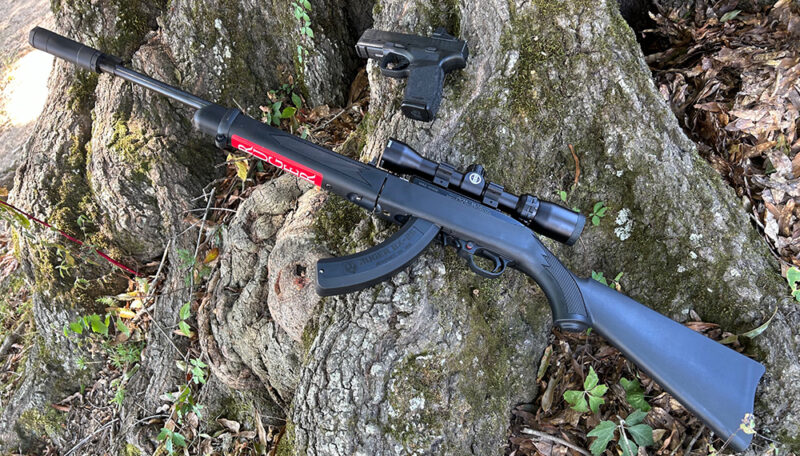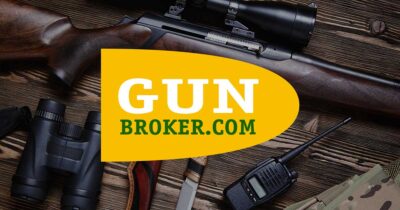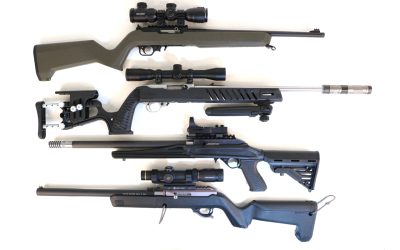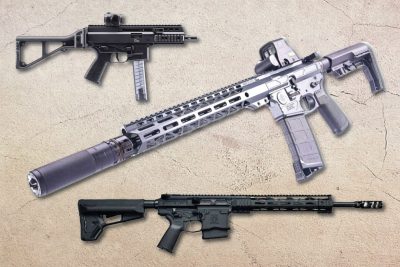One Survival Gun to Rule Them All
By Paul Rackley, GunBroker Editor

There are as many reasons to own a survival gun as there are arguments for survival guns. The best argument, however, is survival in a bad situation.
Lots of people believe the world just can’t continue its present course. The only question is what, and how bad will it be? For that reason, people need to be prepared, whether for famine, pestilence, holocaust or even war.
Firearms are important tools in all these situations; a gun could be the most important tool. And while any gun can be used in a survival situation, having a thought-out survival gun is an excellent idea.
Survival Gun Features
Now, there are two main reasons to own a firearm, defense and food. Any survival gun must be able to perform these duties, bare minimum. Of course, anyone truly familiar with firearms should be able to use any gun for the minimum.
Still, I’ve always believed in having a specific survival gun. One that has been set up with survival in mind; having multiple wouldn’t be a bad idea. This specifically means a long gun and a handgun. Some would say these guns need to be the same caliber, but I prefer two different calibers. The handgun should be in a defensive chambering for stopping attacks, such as 9mm, 40 S&W, 357 Mag., etc. These calibers can drop game at effective ranges, such as 30 to 40 yards for most people. Most folks need a rifle for longer distances.
That rifle, though, needs to be light and easy to carry. Survival situations can be fluid, possibly requiring heading out to better areas. Something easy to carry makes sense, especially if having to walk long distances. A belt fed might be great for battling hoards, it could be tough when bugging out.
Ammunition also needs to be readily available. It’s just easier to find and afford some calibers. The U.S. military’s main calibers are currently 5.56 and 9mm. As such, both can be easily found in any store that sells ammunition. Other popular, easy-to-find calibers include 45 ACP, 30-30 Win. and 30-06 Sprg, as well as the 22 LR. I’ve always liked the 22 LR, as it is available, inexpensive and light. The only question surrounding it, is power or portability?
The last truly important feature on a survival gun are iron sights. I’m a big fan of optics on rifles, especially as my eyes get older. However, Murphy’s law says that bad things happen at the worst possible moment. Scopes can be knocked off or broken and become useless without repair centers. Iron sights allow shooters to continue using the gun.
Choosing a Survival Gun
Like most shooters, I own a variety of firearms. Most of which would work as a survival gun. I set my AR-15 up with every accessory I could, such as backup sights, laser, light, angled foregrip and a 3X optic. This rifle has all the bells and whistles, and would work for pretty much any situation. I also have more powerful firearms, including 30-06 Sprg., 30-30 Win. and more. However, I’ve always leaned toward the venerable 22 LR for survival.
While not powerful, a 22 can bring down most game if the bullet is placed right. It is also small enough to not damage lighter game, such as squirrels or rabbits. An accurate 22 can even bring down birds, including ducks and geese. It just might be the best meat caliber ever brought out.
The 22 LR is, unfortunately, underpowered when it comes to defense. Not a single self-defense expert would recommend this round for a carry gun. It just doesn’t have the stopping power. However, stopping an attack is quite different from survival.
To start, despite it being life and death, defensive situations still have rules of engagement. Typically, these laws explain, to a certain degree, what is legal in a self-defense situation. If the world hits the fan, there will be no rules other than survival and a person’s moral code. It won’t be about “stopping an attack.”
While being underpowered doesn’t automatically mean light, it does in this case. A 22 LR round weighs about 3.3 grams. That measures to .007 pounds or just over one tenth of an ounce. The standard 5.56 weighs between 10 and 12 grams, measuring about four tenths, or four times a 22 LR. This doesn’t sound like much, but a 500-round brick of 22 weighs 3.5 pounds, while 500 rounds of 5.56 weigh 10 pounds. About 1,500 rounds of 22 LR weight the same as 500 rounds of 5.56.
It might take multiple shots on a target, but the lower cost and lighter weight means you can have those extra rounds. Lastly, the 22 LR is easily suppressed. In a situation where everyone could be an enemy, quieter is good.
Ruger 10/22 Takedown — The Chosen One

I’ve never considered a 22 LR to be a fighting gun. It is not the first rifle I’m going to pick up if the country ends up in a Red Dawn situation, but I might carry two or more. Of course, an invasion is not a situation for a survival gun. It is war, requiring a whole different mindset. This doesn’t mean, though, a 22 LR couldn’t be useful or used.
For situations that don’t involve foreign troops, I decided the Ruger 10/22 Takedown makes the best survival gun. This decision came about through research of the features I felt would best benefit me and mine if the world jumps off a cliff.
The Ruger 10/22 Takedown is light, portable and reliable. I purchased the black synthetic stock with the black satin finish on the metal. It came standard with a gold bead front sight and adjustable rear sight. It also come with a threaded barrel and flash hider, and the extremely reliable Ruger 10-round magazine.
I mounted a Bushnell Banner 1.5-4.5X32 scope, purchased a pair of 25-round magazines and ordered a Banish 22K suppressor. Everything easily fits in the included bag, along with a few hundred rounds of CCI Mini-Mag 40-grain. This rifle goes almost everywhere, transporting between vehicles, houses, hotel rooms, etc. This setup might be on the lower end of the power spectrum, but it is the best choice of a survival gun in my eyes.
Savage 42 Takedown — The Runner Up
The Savage 42 Takedown is another easily portable rifle. An advantage it has over some guns is its dual chambering. The 42 is a double barrel, with a 22 LR or 22 WMR on top with a 410 bore on bottom. This provides two opportunities to find ammunition.

The simple design is the next benefit. Break-action guns have few parts to have problems. In a survival situation, this could be a good thing. The Savage 42 features a black, durable stock, matte-black metalwork and adjustable sights. However, the rear sights must be removed to mount a scope. It even comes with a bug-out bag for carrying accessories and ammunition.
Unfortunately, it doesn’t come with a threaded barrel. That, along with the 410 component and the slow reload, kicked this excellent survival gun out of the running. The Taurus Judge is the only 410 I’ve ever considered owning.
Chiappa Double Badger — In the Running
Another dual-caliber double-barrel I considered was the Chiappa Double Badger. Just like the 42, the Double Badger comes with a rifle on top of a shotgun. The Chiappa wins out a little by offering more chamberings. Shooters have choices with the Double Badger of either 22 LR, 22 WMR and 243 Rem. on the rifle side and 410 and 20 gauge with the shotgun.
Personally, I’ve long wanted one in 22 LR/20 gauge, as it would make one heck of a small-game meat gun. This wood and blued firearm is actually quite light at just over 6 pounds. It also uses Rem chokes, and comes with a fiber-optic front sight and an adjustable ghost ring rear sight. It doesn’t, however, come with a way to mount an optic. Nor does it come with threaded barrels.
While it would be great to have the Chiappa Double Badger for hunting, whether in a survival situation or not, this just isn’t the gun I want if I have to bug out. It’s not the fastest to reload, nor can it be suppressed. And while the Double Badger breaks apart, it doesn’t come with a storage bag for carrying accessories or being able to grab and go.

Now, everyone’s survival gun choice is different. This is because people are different. Everyone must determine what is best for his or her personal needs. That doesn’t make anyone’s choice better or wrong. I chose the Ruger 10/22 Takedown with a 9mm pistol, currently a Beretta 92F, because those fit my needs and abilities best.
Related Article: Survival Gun: Crossfire Mk 1 Combination Pump





![Testing the Ruger 10/22 Rimfire on the Farm [Video]](https://content.gunbroker.com/wp-content/uploads/2022/10/An-Introduction-to-Rugers-Infamous-10-22-Video-400x250.jpg)
![How Well Do You Know the Ruger 10/22 Rifle? [Video]](https://content.gunbroker.com/wp-content/uploads/2020/11/gXp2DJwC-1280-400x225.jpg)
![Ruger Security-380 Lite Rack Compact Centerfire Pistol [Video]](https://content.gunbroker.com/wp-content/uploads/2023/02/ruger-Security_380-compact-pistol-400x250.jpg)
![Custom Ruger Precision Rifle RPR 6.5 Creedmoor [Video]](https://content.gunbroker.com/wp-content/uploads/2023/02/New-Custom-Ruger-Precision-Rifle-RPR-6.5-Creedmoor-Video-T0dXRKrB-1280-400x225.jpg)
